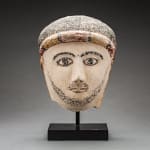Roman Period Stucco Funerary Mask of a Man, 2nd Century CE - 3rd Century CE
Stucco
height 21.6 cm
height 8 1/2 in
height 8 1/2 in
X.0441
Further images
This gorgeous plaster funerary mask reveals that the traditional Egyptian arts continued to flourish even under Roman rule. In fact, the Egyptian style was reinvigorated with a healthy dose of...
This gorgeous plaster funerary mask reveals that the traditional Egyptian arts continued to flourish even under Roman rule. In fact, the Egyptian style was reinvigorated with a healthy dose of Roman classicism that elegantly merges with the stylized traditions of Egypt. Here, a man wearing a diadem has been depicted with textured hair, solemn features, and a tight-lipped expression. Overall, his physiognomy is typical of the multiethnic population of Roman Period Egypt. His skin has been painted a soft creamy hue, while his hair, eyebrows, and neatly trimmed beard and moustache have been painted black. Multiple little painted dots are used to create the beard and moustache. His eyes and lashes have been detailed in black paint, while a thin red line encircling his eyelids heightens the sense of realism. Most of these life-size masks were made for Greek and Roman merchants and administrators who settled in Egypt. They generally show some attempts at portraying an individual, but with conventionalized features. These heads were made separately in molds, with gender-specific details added subsequently, and attached to the mummy case or cartonnage so that they are half raised up off the surface, as if the deceased was just awaking in his new afterlife. The masks were usually painted with realistic colors and some were even gilt. Looking into this mask is like looking into a mirror. It is easy to see ourselves inside this carefully modeled face. We wonder if his life, if his cares and concerns, were really that different than our own?





